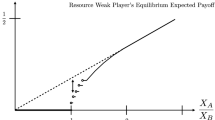Abstract
This paper develops an incomplete information model of extended deterrence relationships. It postulates players who are fully informed about the costs of war and all other relevant variables, save for the values their opponents place on the issues at stake, i.e., the pawn. We provide consistent and intuitively satisfying parallel definitions for two types of players, Hard and Soft, in terms of the parameters of our model. We also answer several particular questions about the strategy choices of players in an extended deterrence relationship and, by identifying all the Perfect Bayesian Equilibria of the game model we construct, specify typical behavior patterns.
Our most general finding is that an Extended Deterrence Game always has a unique Perfect Bayesian Equilibrium with a rather simple form. A challenger initiates for certain if the pawn is valuable enough to it and never challenges otherwise, Likewise, a defender always resists if the pawn is valuable enough and never resists otherwise.
In addition to identifying threshold values for optimal strategic choice, we provide existence conditions for the two distinct types of Perfect Bayesian Equilibria. This permits us to identify the exact set of conditions associated with bluffing strategies and to develop a theory of the necessary and sufficient conditions for extended deterrence crisis initiation and its resolution.
Similar content being viewed by others
References
Aumann, R.: 1976, ‘Agreeing to Disagree’,Annals of Statistics 4, 1236–9.
Banks, J. S.: 1990, ‘Equilibrium Behavior in Crisis Bargaining Games’,American Journal of Political Science 34, 599–614.
Betts, R. K.: 1987,Nuclear Blackmail and Nuclear Balance, Brookings Institution, Washington.
Bueno de Mesquita, B.: 1981,The War Trap, Yale University Press, New Haven.
Bueno de Mesquita, B.: 1985, ‘The War Trap Revisited’,American Political Science Review 79, 156–77.
Bueno de Mesquita, B and D. Lalman: 1992,War and Reason: A Confrontation Between Domestic and International Imperatives, Yale University Press, New Haven.
Bueno de Mesquita, B. and J. D. Morrow: 1991, ‘Capabilities, Perception and Escalation: Testing Limited-Information Hypotheses about Crises’, Unpublished.
Brodie, B. (ed.): 1946,The Absolute Weapon: Atomic Power and World Order, Harcourt Brace, New York.
Fearon, J. D.: 1990, ‘Deterrence and the Spiral Model: The Role of Costly Signals in Crisis Bargaining’, Presented at the annual meeting of the American Political Science Association. San Francisco, CA.
George, A. L. and R. Smoke: 1974,Deterrence in American Foreign Policy, Columbia University Press, New York.
Haig, A. M.: 1984,Caveat: Realism, Reagan and Foreign Policy, Macmillan, New York.
Huth, P.: 1988a,Extended Deterrence and the Prevention of War, Yale University Press, New Haven.
Huth, P.: 1988b, ‘Extended Deterrence and the Outbreak of War’,American Political Science Review 82, 423–43.
Huth, P.: 1990, ‘The Extended Deterrent Value of Nuclear Weapons’,Journal of Conflict Resolution 34, 270–90.
Huth, P. and B. Russett: 1988, ‘Deterrence Failure and Crisis Escalation’,International Studies Quarterly 32, 29–45.
Huth, P. and B. Russett: 1984, ‘What Makes Deterrence Work’,World Politics 36, 496–526.
Intriligator, M. D. and D. L. Brito: 1981, ‘Nuclear Proliferation and the Probability of Nuclear War’,Public Choice 37, 247–60.
Intriligator, M. D. and D. L. Brito: 1984, ‘Can Arms Races Lead to the Outbreak of War?’,Journal of Conflict Resolution 28, 63–84.
Intriligator, M. D. and D. L. Brito: 1987, ‘The Stability of Mutual Deterrence’, in J. Kugler and F. C. Zagare (eds.),Exploring the Stability of Deterrence, Lynne Rienner, Denver, pp. 13–40.
Jervis, R.: 1979, ‘Deterrence Theory Revisited’,World Politics 31, 289–324.
Kaufmann, W.: 1956, ‘The Requirements of Deterrence’, in W. Kaufmann (ed.),Military Policy and National Security, Princeton University Press, Princeton, pp. 12–38.
Kegley, C. W. and E. Wittkopf: 1989,The Nuclear Reader: Strategy, Weapons, War, 2nd ed., St Martin's, New York.
Kilgour, D. M. and F. C. Zagare: 1991, ‘Uncertainty and Deterrence’,American Journal of Political Science 35, 305–34.
Kreps, D. M.: 1990,A Course in Microeconomic Theory, Princeton University Press, Princeton.
Kugler, J. and F. C. Zagare: 1990, ‘The Long-term Stability of Deterrence’,International Interactions 15, 255–78.
Kugler, J.: 1984, ‘Terror Without Deterrence’,Journal of Conflict Resolution 28, 470–506.
Lebow, R. N.: 1984, ‘Windows of Opportunity: Do States Jump Through Them?’,International Security 9, 147–86.
Morgan, P. M.: 1983,Deterrence: A Conceptual Analysis, 2nd ed., Sage, Beverly Hills.
Morrow, J. D.: 1989a, ‘Capabilities, Uncertainty, and Resolve: A Limited Information Model of Crisis Bargaining’,American Journal of Political Science 33, 941–72.
Morrow, J. D.: 1989b, ‘Bargaining in Repeated Crises: A Limited Information Model’, in P. C. Ordeshook (ed.),Models of Strategic Choice in Politics, University of Michigan Press, Ann Arbor, pp. 207–28.
Nalebuff, B.: 1986, ‘Brinkmanship and Nuclear Deterrence: The Neutrality of Escalation’,Conflict Management and Peace Science 9, 19–30.
Organski, A. F. K. and J. Kugler: 1980,The War Ledger, University of Chicago Press, Chicago.
Powell, R.: 1990,Nuclear Deterrence Theory: The Search for Credibility, Cambridge University Press, New York.
Russett, B.: 1963, ‘The Calculus of Deterrence’,Journal of Conflict Resolution 7, 97–109.
Snyder, G. H. and P. Diesing: 1977,Conflict Among Nations: Bargaining, Decision Making and System Structure in International Crises, Princeton University Press, Princeton.
Tirole, J.: 1988,The Theory of Industrial Organization, MIT Press, Cambridge, MA.
Wagner, R. H.: 1991, ‘Nuclear Deterrence, Counterforce Strategies, and the Incentive to Strike First’,American Political Science Review 83, 727–49.
Waltz, K. N.: 1979,Theory of International Politics, Addison-Wesley, Reading, MA.
Weede, E.: 1981, ‘Preventing War by Nuclear Deterrence or by Detente’,Conflict Management and Peace Science 6, 1–8.
Weede, E.: 1983, ‘Extended Deterrence by Superpower Alliance’,Journal of Conflict Resolution 27, 231–53.
Wu, S. S. G.: 1990, ‘To Attack or Not to Attack: A Theory and Empirical Assessment of Extended Immediate Deterrence’,Journal of Conflict Resolution 34, 531–52.
Zagare, F. C.: 1987,The Dynamics of Deterrence, University of Chicago Press, Chicago.
Zagare, F. C. and D. M. Kilgour: 1993, ‘Asymmetric Deterrence’,International Studies Quarterly 37, 1–27.
Author information
Authors and Affiliations
Rights and permissions
About this article
Cite this article
Kilgour, D.M., Zagare, F.C. Uncertainty and the role of the pawn in extended deterrence. Synthese 100, 379–412 (1994). https://doi.org/10.1007/BF01063909
Issue Date:
DOI: https://doi.org/10.1007/BF01063909




